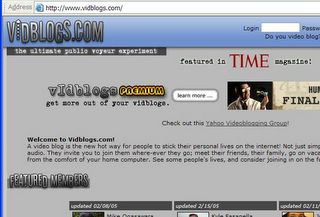The items in this bibliography are referenced in the sections above.
Bulkeley, William M. (2005, June 23)
Marketers Scan Blogs for Brand Insights. Wall Street Journal. B1, B6.
Carr, Nora (April 1, 2005). Educator blogs could boost respect for teachers--and expose classroom challenges. eSchoolNews, Retrieved April 14, 2005, from
http://www.eschoolnews.com/news/showStory.cfm?ArticleID=5601Chen, Anne (2004). RSS Makes Enterprise Headlines. eWeek. Retrieved September 20, 2004, from
http://www.eweek.com/article2/0,1759,1646538,00.aspDeflem, Mathieu. 1996. “Introduction: Law in Habermas’s Theory of Communicative Action.” Pp. 1-20 in Habermas, Modernity and Law, edited by Mathieu Deflem. London: Sage. Retrieved June 9, 2005, from
http://www.cas.sc.edu/socy/faculty/deflem/zhablaw.htmDewey, John (1916). Democracy and Education. New York: Macmillan. Retrieved on June 6, 2005, from
http://www.ilt.columbia.edu/publications/dewey.htmlFesta, Paul (2003). Battle of the Blogs. CNET. Retrieved August 4, 2003, from
http://news.com.com/2009-1032-5059006.html?part=dht&tag=ntopFesta, Paul (2004). Blog Format Truce Proposed. ZDNET. Retrieved March 9, 2004, from
http://news.zdnet.com/2100-3513_22-5171882.html?tag=nlGillmor, Dan (2004). We the Media: Grassroots Journalism by the People, for the People. Sebastopol, CA : O'Reilly. Retrieved June 22, 2005, from
http://www.oreilly.com/catalog/wemedia/book/Glen, David (2003, June 6). Scholars Who Blog. Chronicles of Higher Education. Section: Research & Publishing, 49 (39), A14. Retrieved June 14, 2005, from
http://chronicle.com/free/v49/i39/39a01401.htmGlogoff, Stuart (2005. Instructional blogging: Promoting interactivity, student-centered learning, and peer input. Innovate 1 (5). Retrieved June 9, 2005, from
http://www.innovateonline.info/index.php?view=article&id=126Goodwin-Jones, Bob (May 2003). Blogs and Wikis: Environments for On-Line Collaboration. Language Learning & Technology, 7(2) p12-16. (ERIC EJ666342) Retrieved May 17, 2005, from
http://llt.msu.edu/vol7num2/emerging/default.htmlHabermas, Jurgen (1984). The Theory of Communicative Action: Reason and the Rationalization of Society; translated by Thomas McCarthy. Two volumes. Boston : Beacon Press.
Hesseldahl, Arik (2005, May 27). Radio Must Change. Here's How. Forbes. Retrieved May 27, 2005, from
http://www.forbes.com/technology/personaltech/2005/05/27/cx_ah_0527diglife.htmlHicks, Matt (2004). Apple's RSS Embrace Could Bolster Adoption. eWeek. Retrieved June 28, 2004, from
http://www.eweek.com/article2/0,1759,1618128,00.aspHuffaker, D. (2005). The educated blogger: Using weblogs to promote
literacy in the classroom. AACE Journal, 13(2), 91-98.
http://www.editlib.org//index.cfm/files/paper_5680.pdf?fuseaction=Reader.DownloadFullText&paper_id=5680Jardin, Xeni (2005, May). Podcasting Killed the Radio Star. Wired News. Retrieved May 14, 2005, from
http://www.wired.com/news/digiwood/0,1412,67344,00.htmlLasica, J.D. (August 18, 2004). Transparency Begets Trust in the Ever-Expanding Blogosphere, USC Annenberg Online Journalism Review. Retrieved January 4, 2005, from
http://ojr.org/ojr/technology/1092267863.phpKrause, Steven D. (2005, June 24).
Blogs as a Tool for Teaching. Chronicles of Higher Education, B33-35.
Mossberg, Walter (2005, June 15). Taking the Mystery Out of Blog Creation. Wall Street Journal, D4. Retrieved June 15, 2005, from
http://online.wsj.com/public/article/0,,SB111878431732959531-Hc5m3ctbnR1Dnv4yoCiNZq71qFc_20060614,00.html?mod=public_home_usNaughton, Philippe (September 22, 2005). How to be a cyber-dissident - handbook offers advice. Times Online. Retrieved September 22, 2005 from
http://www.timesonline.co.uk/article/0,,3-1792375,00.htmlNeedleman, Sarah E. (2005, May 31). Blogging Becomes a Corporate Job; Digital 'Handshake'? Wall Street Journal, B1, p.1.
Nesbitt, Alex (2005, June). The Podcast Value Chain Report: An Overview of the Emerging Podcasting Marketplace. Retrieved June 20, 2005, from
http://www.digitalpodcast.com/podcastvaluechain.pdfPew Internet & American life Project (2005). New data on blogs and blogging. Retrieved July 22, 2005 from
http://www.pewinternet.org/PPF/r/104/press_release.aspPodcasting News (June 30, 2005). Apple Extends Dominance in Online Music to Podcasting. Retrieved June 30, 2005 from
http://www.podcastingnews.com/archives/2005/06/apple_extends_d.htmlRichardson, Will (2005, June). New Jersey High School Learns the ABCs of Blogging. T.H.E. Journal, 40.
Tonkin, Emma (January 30, 2005). Making the Case for a Wiki. Ariadne. 42, Retrieved June 3, 2005, from
http://www.ariadne.ac.uk/issue42/tonkin/intro.htmlVygotsky, L. S. (1978). Mind in society. Cambridge, MA: Harvard University Press.
Wenger, E., R. McDermott, and W. M. Snyder. (2002). Cultivating communities of practice. Boston: Harvard Business School Press.
Wikipedia.org's article titled Blog, Retrieved June 16, 2005, from
http://en.wikipedia.org/wiki/BlogWikipedia.org's article titled Podcasting, Retrieved June 18, 2005, from
http://en.wikipedia.org/wiki/PodcastingOther Bibliographies on Blogging
A Weblog Webliography
http://kairosnews.org/blogbibA
search of Amazon.com shows over 90 books on blogging.





